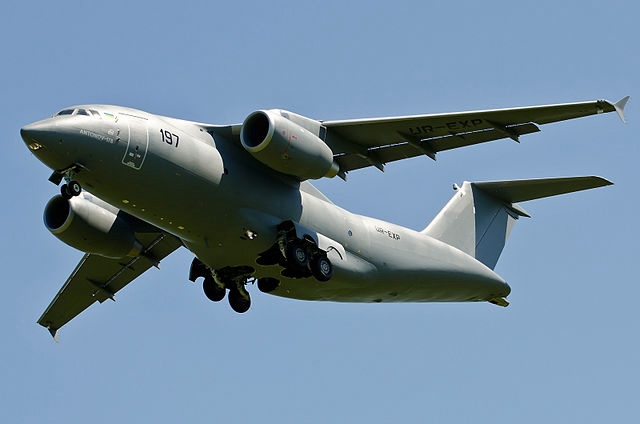An-178
Summary
| Category | Military Transport Aircraft |
| Origin country | 🇺🇦 Ukraine |
| Manufacturer | Antonov |
| First flight | 7 May 2015 |
| Year introduced | |
| Number produced | 1 units |
| Average unit price | $52 million |
Description
The Antonov An-178 project was initiated in 2009 by Antonov as a self-financed endeavor to create a successor to the company's Soviet-era An-12, An-26, and An-32 transport aircraft, and to replace aging international types like the Transall C-160. Market research indicated a need for an aircraft with a payload capacity optimized for 13 to 18 tonnes. Detailed design work commenced in 2011, basing the new transport on the An-148 and An-158 family. The main fuselage of the first prototype was completed by July 2014. This prototype was rolled out on 16 April 2015, and performed its maiden flight on 7 May 2015, roughly two years behind the original schedule for flight testing. Antonov initially decided to install D-436-148FM engines on the first prototype, a derivative of the D-436-148 with an upgraded fan boosting takeoff thrust to 7,800 kgf, as potentially an interim measure while awaiting more powerful new-generation turbofans. The company planned to build over 200 aircraft, securing an order from the Ministry of Internal Affairs of Ukraine for 13 units in June 2019, and in January 2021, an order for three An-178s for the Ukrainian Air Force was announced, with fuselage fabrication for the first of these completed by May 2021. Construction of the first production An-178 was declared complete in December 2021, followed by the commencement of certification testing.
Derived from the An-158 regional airliner, the Antonov An-178 is a high-wing transport aircraft featuring a moderately swept wing with winglets and a T-tail. It shares the An-158's F1 fuselage nose section, flight deck, wing panels, empennage, and most onboard systems, but incorporates a newly designed fuselage with an enlarged diameter (from 3.35 m to 3.9 m), resulting in a cargo cabin cross-section of 2.75 m by 2.75 m. The airframe is constructed from aluminium alloys and composite materials, with a semi-monocoque fuselage. Unique features include an extra pair of tandem main-wheels on each side compared to the An-158 and a fully pressurised cargo compartment. Avionics are similar to the An-148, featuring digital systems and a dual duplex fly-by-wire flight control system with an emergency mechanical cable back-up. The aircraft is powered by two Progress D-436-148FM turbofan engines mounted on underwing pylons and is equipped with an auxiliary power unit. Its design emphasizes limited reliance on airport infrastructure, enabling operations from austere airstrips.
The An-178 is designed to transport a variety of payloads. It has a maximum payload capacity of 18 tonnes, which it can carry over a distance of 1,000 km, or it can transport 10 tonnes over 4,000 km. Its fully pressurised cargo compartment allows for the transport of diverse military loads, including standardised cargo containers. For personnel transport, it can accommodate a maximum of 99 infantry personnel with full combat equipment, up to 80 paratroopers, or it can be configured for medical evacuation with capacity for 40 casualties on litters plus 30 seated casualties, or 8 medical modules and 12 personnel. Specifications also note capacity for 90 soldiers or 70 paratroopers.
The An-178 was still in development as of 2020, with the first prototype conducting its maiden flight on 7 May 2015. By May 2017, it had accumulated over 194 flight hours across 115 test flights. The aircraft made its Western debut at the 2015 Paris Air Show, where Antonov announced initial orders and discussed potential production agreements with Azerbaijan and China. It was also showcased at the Dubai Airshow in November 2015, after which a letter of intent for 30 aircraft was signed with the Royal Saudi Air Force, though this order was later reported as cancelled. Orders were placed by the Ministry of Internal Affairs of Ukraine for 13 aircraft and the Ukrainian Air Force for three aircraft. An order from Peru for one aircraft was later cancelled. The aircraft is promoted for its ability to operate from austere airfields and its incorporation of modern air freight standards, offering reduced maintenance and smaller crew requirements compared to its predecessors.
Main Variants
- AN-178-100P: A military transport variant ordered by the Ukrainian Air Force.
Technical specifications
| Version: An-178 | |
|---|---|
| Crew | 2 |
| Operational range | 4,700 km (2,920 mi) |
| Maximum speed | 990 km/h (615 mph) |
| Wingspan | 30.6 m (100.3 ft) |
| Height | 9.6 m (31.4 ft) |
| Length | 32.2 m (105.7 ft) |
| Service ceiling | 12,000 m (39,370 ft) |
| Max. takeoff weight | 51,000 kg (112,436 lbs) |
| Powerplant | 2 x Progress D-436-148FM Turbofan delivering 7502 kgf each |
Current operating countries
All operators
